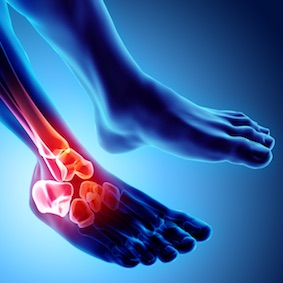What is a heel spur?
A heel spur is a build-up of calcium deposits under the heel bone; where the tendon which runs to the forefoot attaches. Heel spurs don’t necessarily lead to any complaints, but extensive heel strain can cause inflammation of the plantar fascia ligament at the bottom of the foot. This can produce an intense, chronic pain at the bottom of your foot near the heel.
Heel spur complaints and symptoms
Heel spur symptoms often include:
- Pain on the bottom of the heel, especially in the morning or after sitting still for a while. The pain is often just felt at the front of the heel but can sometimes extend into the entire sole of the foot. A short walk to warm up usually helps although it might take a while to feel an improvement. When nerves and veins have relaxed for a while, getting up suddenly puts them under a lot of pressure. The nerves readjust after a short walk and the heel pain will subside. In more serious cases of heel spur, however, this won’t lead to any improvement.
- Standing still for a long while is painful. This especially causes discomfort for people with jobs that require standing up for extended periods of time.
- Driving is unpleasant. Heel pain while driving a car is a very common heel spur symptom. This is caused by the unnatural positioning of the foot.
The longer heel spurs are left untreated, the harder it will be to treat them.
Heel spur prevalence and who it affects
About 30 to 75% of the Dutch population has developed heel spurs but only a very small proportion is aware of it: 10% will experience pain. Runners are especially susceptible for this type of injury. People under the age of 45 are not very likely to be affected by heel spurs. Children can experience symptoms similar to heel spurs but which should in fact be attributed to Sever’s Disease. This condition usually goes away when the strain to the foot is properly managed. Factors that can lead to increased risk of heel spurs include; sports related overuse, improper footwear, hiking, obesity and having to stand up often and for a long time. A tight calf muscle, overpronating (having flat feet) or underpronating (having high arches), nerve entrapment, degeneration of the heel fat pad (mainly in older people), a tight sole (when for instance a shoe doesn’t provide sufficient cushioning) can also trigger heel spurs.
Self-help for heel spur
Heel spurs hardly ever go away by themselves, but they are easy to treat. Make sure you have recognised the symptoms in time and take plenty of rest. Try and avoid walking, running and standing as much as possible at first. Insoles can be a great solution as they enhance foot pressure distribution and relieve the fascia plantaris somewhat. A podiatrist will be able to offer appropriate advice.
Book an appointment
Physiotherapy treatment for heel spurs
Physiotherapy will focus on building up strength in your tendons, bones and muscles. A physiotherapist will use several different methods to help improve your gait and your posture. If necessary and only after consulting your GP, he can refer you to a podiatrist. Additionally, he can provide you with relevant stretching exercises, help you to build up strength in your muscles and simulate your blood circulation – and thereby tendon rehabilitation – through a deep tissue massage technique.
Rest in combination with physiotherapy often produces good results but can sometimes also be rather time consuming. Therefore, in some cases, alternative treatment methods are available as well. A physiotherapist is available for advice. Depending on how quickly you are diagnosed, how much rest you can take and the type of exercises you are doing, the pain should be gone within a couple of weeks to a couple of months.
Which other physical complaints does FysioCity treats?
Book an appointment
 NL
NL